Scientific name: Ephedra equisetina
Common names: bluestem ephedra, bluestem joint fir
Scientific name: Ephedra torreyana
Common names: Mormon tea, joint fir
Plant Family: Ephedraceae (joint fir)
Article and photos by Janice Tucker
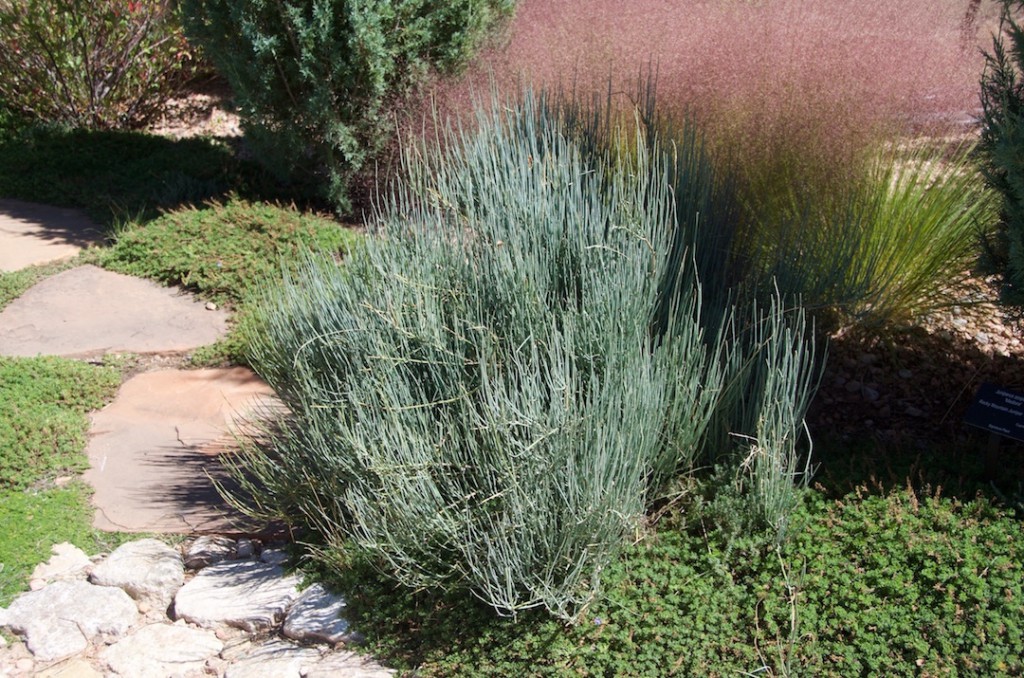
Ephedra equisetina (bluestem joint fir) growth habit early fall (Photo: J. Tucker)
The Ephedra’s unique and rather austere structure often prompts the question, “What can you tell me about this plant?” Apparently it is a shrub of sorts, but even in the height of summer, where are the leaves? Those blossoms look a bit strange too. Even so, the simplicity of its formation is intriguing and complements the surrounding bushier and more colorful plants. Its attractive yet unassuming presence belies the considerable botanical and medicinal significance of its long existence. Suffice it to say that delving into the fascinating characteristics of the Ephedra can easily become extensive lessons in botany and medicinal history.
As gymnosperms, Ephedras produce male pollen cones and female seed cones rather than flowers – but do not necessarily resemble what most of us visualize as cones. The majority of Ephedras are dioecious, signifying that there are separate male and female plants and that both need to be in the same general area in order to reproduce. There are also some monoecious Ephedras (pollen and seed cones on the same plant). The slender, jointed branches and tiny leaves efficiently process moisture, accounting for their preference for semi desert climates and the dry, sandy or rocky soils of canyons, mesas and grassy fields. The leaves are so small that photosynthesis can only occur through the branches. The growth habit and branch size appear to be like closely bunched horsetails on steroids. But horsetails belong in the Equisetaceae plant family, which is in the fern and fern allies division of the plant kingdom – not in the gymnosperm division. However, there is a structural similarity and that might cause one to idly speculate if this could be one of those botanical mysteries hovering around the edges of Ephedra’s evolution.
With over 40 species, the Ephedra is the only genus in the Ephedraceae plant family. They are native to the southwestern United States as well as South America and regions of Europe, Asia and Africa. Each of the Santa Fe Botanical Garden sites has an Ephedra species. The Ephedra equisetina, native to China, Siberia, and Mongolia, is in the Botanical Garden at Museum Hill and the southwestern United States native Ephedra torreyana grows in the dry, grassy upland areas of the Leonora Curtin Wetland Preserve.
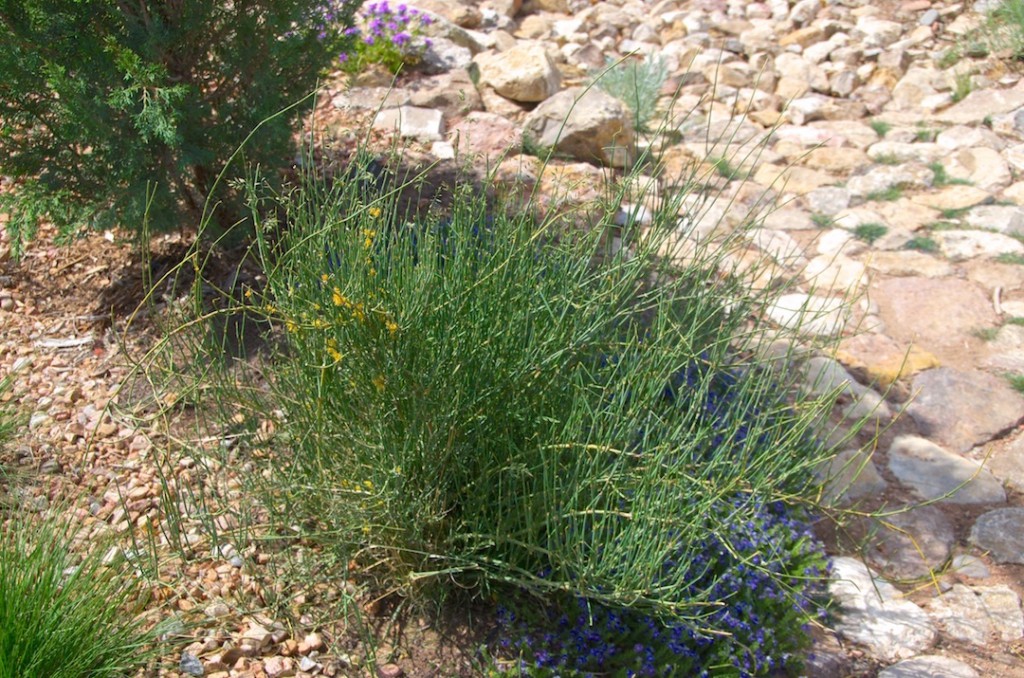
Ephedra equisetina (bluestem joint fir) in spring with cones by (Photo: J. Tucker)
Ephedra equisetina is an attractive addition to the garden no matter the season. Commonly known as the bluestem joint fir, it gradually changes from a vibrant green to a soft blue-green hue later in the year. Its vertical growth habit of jointed, almost bare branches sets it apart from the garden shrubs with more luxuriant foliage. The E. equisetina is dioecious. In mid spring small, spiky, yellow pollen cones from the male plant and seed cones from the female plant burst from nodes that line the stems. The female’s seed cones mature to small, plump, red berry-like fruits.
E. equisetina and most Ephedra species prefer sun, and very little extra water, which should appeal to xeric gardening aficionados. The equisetina species readily spreads by sprouts, so be prepared to pull up the suckers as soon as they appear in order to contain its lateral growth. However, if planted in a large, bare spot that begs to be covered, the E. equisetina will happily follow its inherent tendency to fill it as long as the area offers growing conditions friendly to its existence.
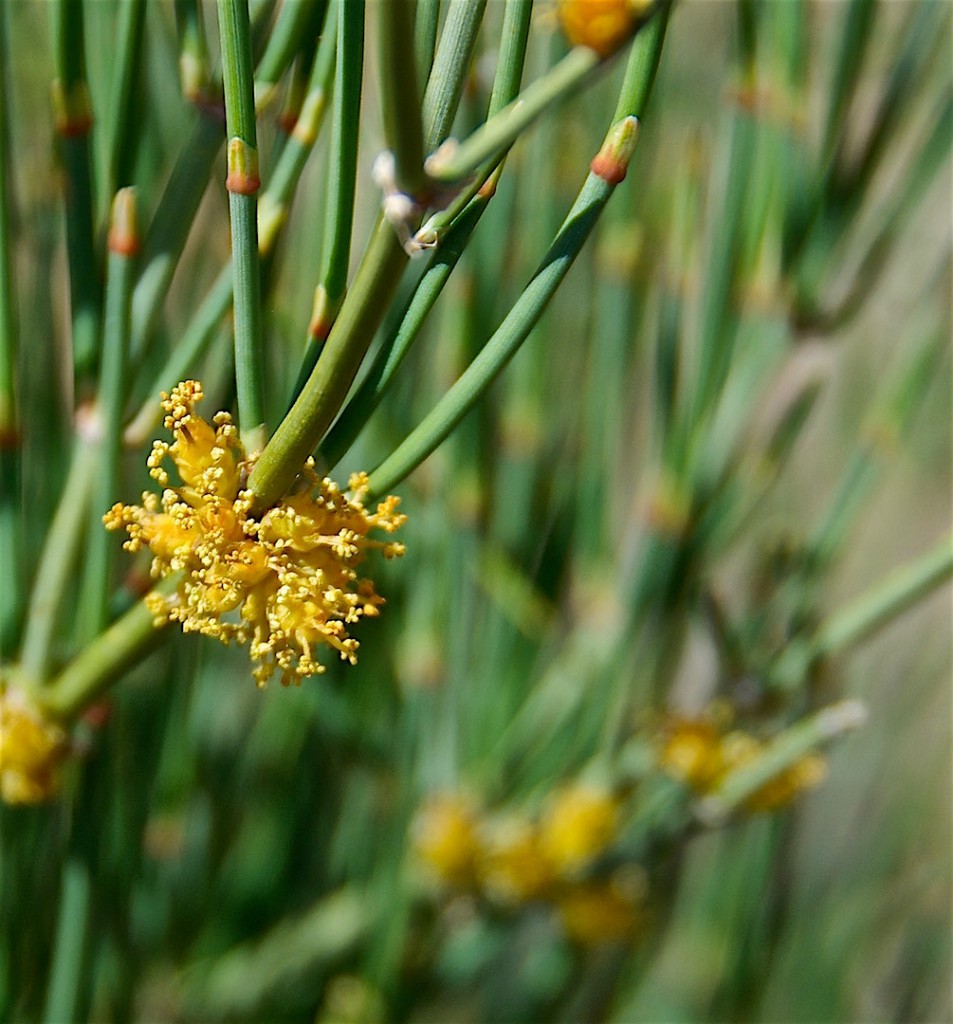
Ephedra equisetina (bluestem joint fir) male strobili with protruding microsporophylls with anthers extending out (Photo: J. Tucker)
Named for the 19th century botanist, Dr. John Torrey, the Ephedra torreyana’s slender, jointed branches are networked rather than vertical and turn from a dark green in spring to gray in autumn and winter. It is also dioecious with the pollen and the seed cones appearing on separate plants in mid-to-late spring. People of the Mormon faith brew a tea from these plants and have
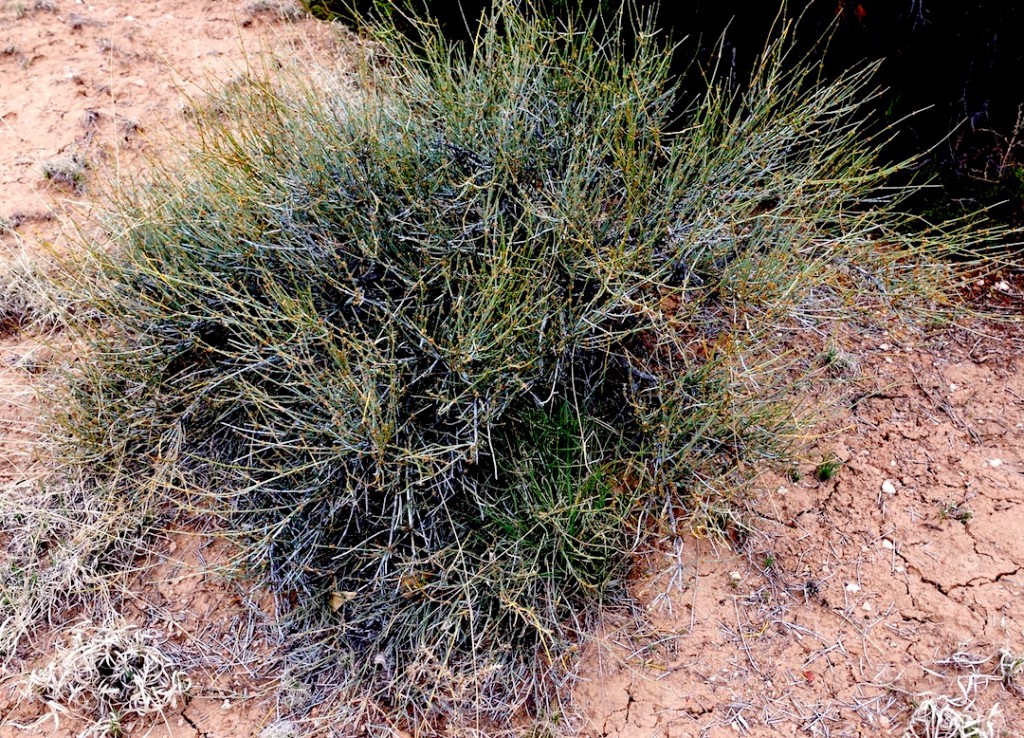
Ephedra torreyana (Mormon tea). Photo: J. Tucker
bestowed the common name of Mormon tea upon several of the American Ephedra species. It should be noted that the Ephedra species native to the southwestern United States, which includes the E. torreyana, do not have as high an ephedrine potency contained in the Asian varieties.
There are claims that Ephedra pollen was found in the Shanidar IV burial site in Iraq. This suggests that its use as a medicinal plant dates to over 60,000 years ago. But for now let’s just travel back in time to 5000 BC when the Chinese discovered a particularly potent concentrate of ephedrine in the Ephedra species, ma huang. They found ephedrine to be very effective in treating various illnesses, particularly respiratory ailments. However, it took a while to realize that along with the benefits there was a danger of incurring harmful side effects caused by overdosing on ephedrine. Back in 5000 BC there were no lists warning of potential problems. So we can assume that some folks inadvertently took too much ephedrine for a cough or other respiratory illness and may have also suffered from the side effects. Some of the more serious problems resulting from an overdose are seizures, myocardial infarction, heart rhythm abnormalities, nervous system problems, loss of consciousness and even death. Talk about the cure being worse than the disease! More caution was taken in prescribing dosages once too much ephedrine was tied to the severe side effects.
Throughout its long, historical odyssey Ephedra has been and still is valued for its medicinal properties. But because it can also cause serious problems, its medicinal usage is now strictly controlled in most countries. Pharmaceutical companies have developed synthetic compounds for producing medicines with an ephedrine ingredient.
Once a plant’s history is revealed, it takes on an added dimension. And the distinctive Ephedras have quite a story to tell. That elegant, blue-green Ephedra equisetina in the garden and the robust, wiry Ephedra torreyana growing naturally in a dry, grassy field share a long, distinguished heritage. If the Ephedra’s unique form and its intriguing ethnobotany hold your interest, then these plants may very well be just your cup of tea.
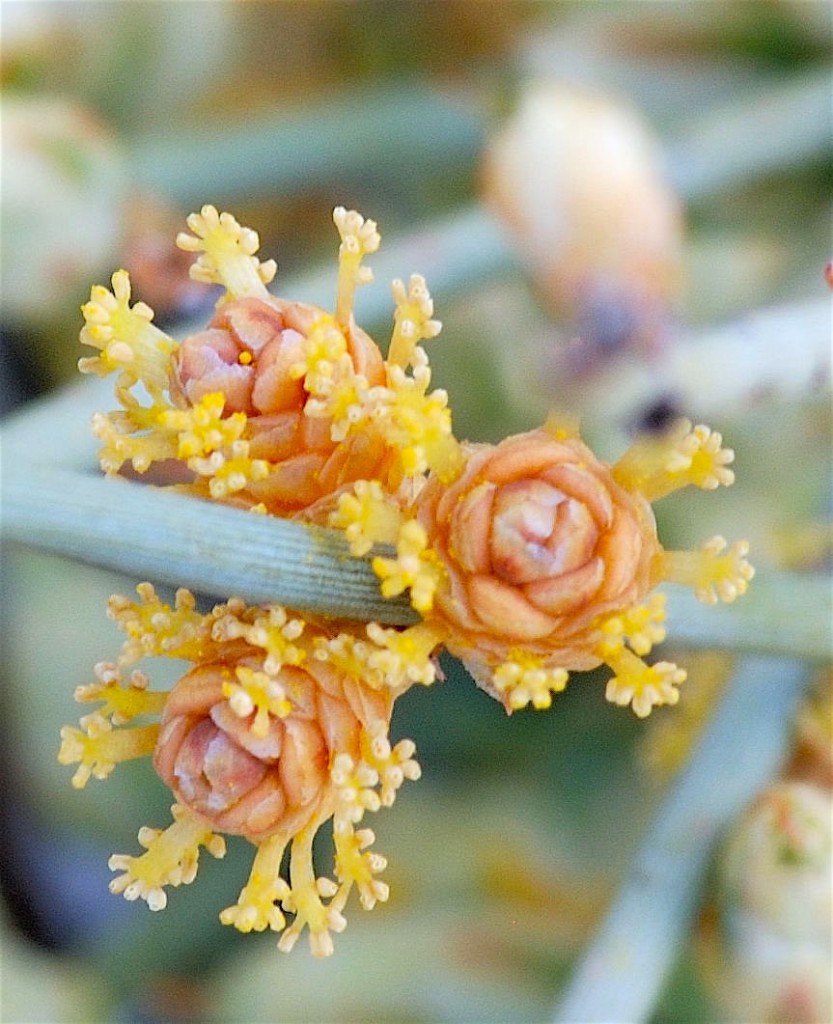
Ephedra torreyana (Mormon tea) male strobili with protruding microsporophylls with anthers extending out (Photo: J. Tucker)
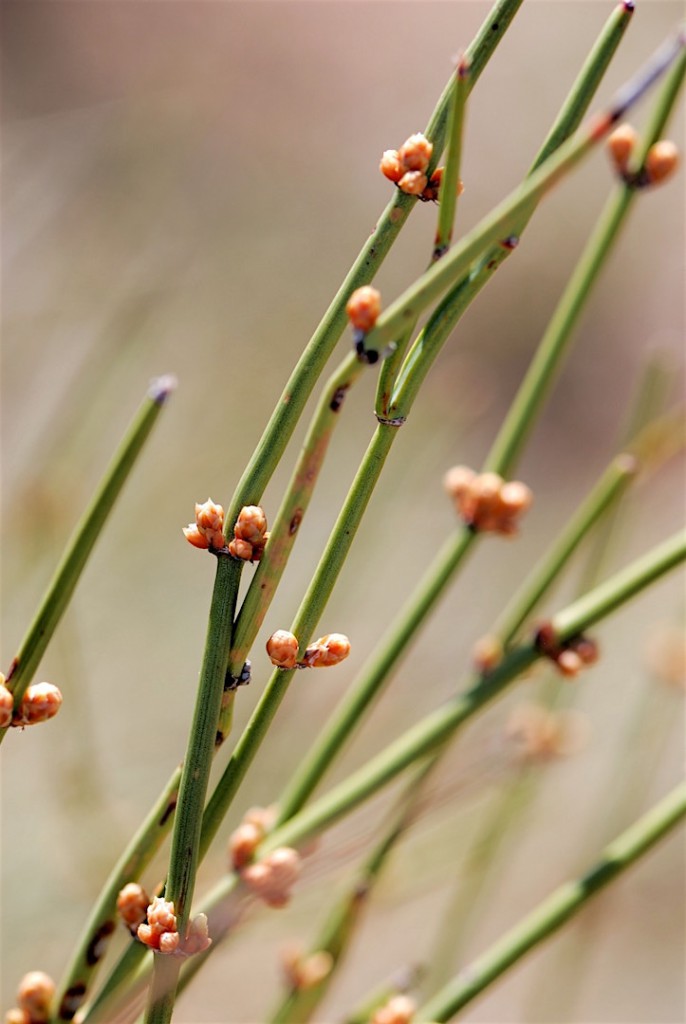
Ephedra torreyana (Mormon tea) strobili at a young stage and unclear whether male or female.
Thanks to Helen Woody and Jeanne Gozigian for proofreading this article.
Works consulted:
Cambridge University Botanic Garden, “Ephedra”, http://www.botanic.cam.ac.uk/Botanic/Plant.aspx?p=27&ix=64&..
Courage Garden, “Bluestem Joint Fir Ephedra equisetina”, http://couragegardenplants.com/bluestem-joint-fir/
Curtin, L.S.M., Healing Herbs -Traditional Medicine of the Southwest, Revised edition by Michael Moore, 1987, Western Edge Press, 126 Candelario Street, Santa Fe, New Mexico 87501
Flora of China, “Ephedra equisetina”, http://www.efloras.org/florataxon.aspx?flora_id=2&taxon_id=200005505
Moore, Michael, Medicinal Plants of the Mountain West, Copyright 2003 Michael Moore, Museum of New Mexico Press, Post office Box 2087, Santa Fe, NM 87504.
Plants for a Future, “Ephedra torreyana – S. Watson”, Database http://www.pfaf.org/user/Plant.aspx?LatinName=Ephedra+torreyana
Santa Fe Botanical Garden, “Ephedra equisetina”, Plant Photo Gallery and Database, https://visitsfbg.org/explore-nature/plant-1, and “Ephedra torreyana”
https://visitsfbg.org/explore-nature/plant- database/?ttl=Ephedra&keywords=&go=Search&gazpart=view&gazgal=5349&gazimage=417
SEINet, Arizona Chapter, “Flora of North America – Ephedra torreyana” http://swbiodiversity.org/seinet/taxa/index.php
Schneider, Al, “Ephedra”, Southwest Colorado Wildflowers, http://www.swcoloradowildflowers.com/Yellow%20Enlarged%20Photo%20Pages/ephedra.htm
Wikipedia , Ephedra (plant)”, https://en.wikipedia.org/wiki/Ephedra_(plant)
World Botanical, “Ephedra –Ephedraceae” http://www.worldbotanical.com/ephedra.htm


